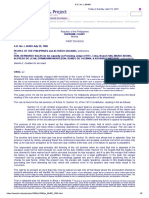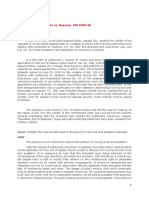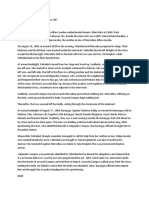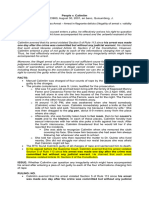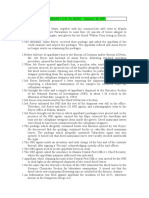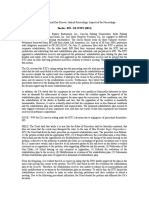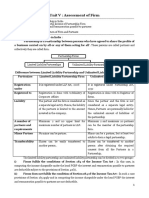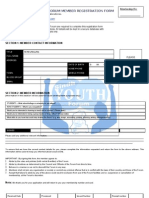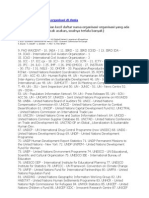People v. Pinlac - 165 SCRA 675 (1988)
People v. Pinlac - 165 SCRA 675 (1988)
Uploaded by
Jasmine LeañoCopyright:
Available Formats
People v. Pinlac - 165 SCRA 675 (1988)
People v. Pinlac - 165 SCRA 675 (1988)
Uploaded by
Jasmine LeañoOriginal Description:
Original Title
Copyright
Available Formats
Share this document
Did you find this document useful?
Is this content inappropriate?
Copyright:
Available Formats
People v. Pinlac - 165 SCRA 675 (1988)
People v. Pinlac - 165 SCRA 675 (1988)
Uploaded by
Jasmine LeañoCopyright:
Available Formats
LEAO, JASMINE
Article III. Section 12. VII. The Exclusionary Rule. A. Violation of Rights
People v. Pinlac 165 SCRA 675 [1988]
FACTS: 2 charges were filed against Ronilo Pinlac. The first one is Robbery by entering the house of Koji
Sato and carrying away some valuable articles. The second one is Robbery with Homicide by entering the
house of Saeki Osamu, carrying away a Hitachi Casette Tape Recorder and by stabbing Osamu with a
kitchen knife resulting to the death of the latter.
Mr. Koji Sato had a cook by the name of Delia Marcelino. The latter was employed for almost a year; she
went on maternity leave since she was due to deliver a child with her husband, Pinlac (accused), who had
frequently visited her in Satos place. On the day of the incident, Sato went out of his house. Returning
home at around 11:30 in the evening of the same day, Sato noticed that the front door was already
unlocked. He found out that his watch, a gold necklace, and cash money amounting to P180.00, were all
missing. Sato went to the Makati Police Station to report the robbery. It was when the police investigators
had already reached his residence that he learned about the death of Osamu. Osamus maid revealed that
she saw Pinlac enter the house of Sato and did not see him leave thereafter. The police arrested the accused
and the latter executed an extrajudicial confession.
The version of the defense is as follows: the accused has never left the premises of his house; this fact was
corroborated by witness Barcelino Heramis. Then 3 policemen, came to his house and arrested the accused
for robbing Mr. Sato and for killing Mr. Osamu, without any Warrant of Arrest shown to him despite his
demand. Before he was brought first to the houses of Mr. Sato and Mr. Osamu, walked him around and
showed him the destroyed window; and thereafter brought him inside the house. In short, he was ordered to
reenact according to what the police theorized how the crime was committed. It was at this moment that the
prints of the sole of accuseds shoes were all over the premises of Osamu and Satos houses.
During the investigation at the Police Headquarters in Makati, he was tortured and forced to admit the
crimes charged; and as a result of that unbearable physical torture, his lips and mouth suffered cuts and
cracks to bleed furiously. When accused could no longer bear the torture for seven (7) solid hours when he
ultimately succumbed to the wishes of his torturers and finally signed a prepared confession which he was
not even allowed to read, nor explained to him.
ISSUE: W/N extrajudicial confession was admissible in evidence. NO.
HELD: When the Constitution requires a person under investigation to be informed of his right to remain
silent and to counsel, it must be presumed to contemplate the transmission of a meaningful information
rather than just the ceremonial and perfunctory recitation of an abstract constitutional principle. As a rule,
therefore, it would not be sufficient for a police officer just to repeat to the person under investigation the
provisions of the Constitution. He is not only duty-bound to tell the person the rights to which the latter is
entitled; he must also explain their effects in practical terms. In other words, the right of a person under
interrogation to be informed implies a correlative obligation on the part of the police investigator to
explain, and contemplates an effective communication that results in understanding what is conveyed.
Short of this, there is a denial of the right, as it cannot truly be said that the person has been informed of
his rights.
It is the duty of the prosecution to affirmatively establish compliance by the investigating officer with his
said obligation. Absent such affirmative showing, the admission or confession made by a person under
investigation cannot be admitted in evidence.
The evidence for the prosecution failed to prove compliance with these constitutional rights. Furthermore,
the accused was not assisted by counsel and his alleged waiver was made without the assistance of counsel.
The record of the case is also replete with evidence which was not satisfactorily rebutted by the
prosecution, that the accused was maltreated and tortured for 7 solid hours before he signed the prepared
extra-judicial confession.
You might also like
- Being The SolutionDocument270 pagesBeing The SolutionJJkaz100% (2)
- Bank Proof of Funds PDFDocument1 pageBank Proof of Funds PDFPit Byll60% (5)
- G.R No. L-66469Document2 pagesG.R No. L-66469Edwino Nudo Barbosa Jr.No ratings yet
- GAMSAT Practice EssayDocument2 pagesGAMSAT Practice EssayHaseeb RayhanNo ratings yet
- G.R. No. 166040, Neil Llave vs. People of The Philippines, April 26, 2006Document2 pagesG.R. No. 166040, Neil Llave vs. People of The Philippines, April 26, 2006Amicus CuriaeNo ratings yet
- Evidence DigestDocument3 pagesEvidence DigestseventhwitchNo ratings yet
- Landbank vs. CADocument1 pageLandbank vs. CAIrish PrecionNo ratings yet
- Fajardo Vs CADocument2 pagesFajardo Vs CALeo Angelo MenguitoNo ratings yet
- People v. AminnudinDocument11 pagesPeople v. AminnudinJames Evan I. Obnamia100% (1)
- PP Vs Marcos Daw (117 SCRA 999)Document7 pagesPP Vs Marcos Daw (117 SCRA 999)Ten LaplanaNo ratings yet
- De Jonge v. Oregon: Assembly and Petition For Redress To Grievances The Purpose TestDocument1 pageDe Jonge v. Oregon: Assembly and Petition For Redress To Grievances The Purpose TestMa Gabriellen Quijada-TabuñagNo ratings yet
- Consti2 13th CompilationDocument33 pagesConsti2 13th CompilationRollyn Dee De Marco PiocosNo ratings yet
- Rufino Lopez v. Court of Tax AppealsDocument1 pageRufino Lopez v. Court of Tax AppealsfabsfabsNo ratings yet
- PP vs. MengoteDocument1 pagePP vs. MengoteDana Denisse RicaplazaNo ratings yet
- G.R. No. 110097 December 22, 1997 FactsDocument1 pageG.R. No. 110097 December 22, 1997 FactsEnn Arr Angeles TapocNo ratings yet
- Ayer V CapulongDocument4 pagesAyer V CapulongAntonino Borja BormateNo ratings yet
- Serafin Vs LindayagDocument1 pageSerafin Vs LindayaggerlynNo ratings yet
- Constitutional Law: VALLEJO VS CA: Requisites For Issuing Search WarrantDocument1 pageConstitutional Law: VALLEJO VS CA: Requisites For Issuing Search WarrantChenny AbellaNo ratings yet
- Gonzales v. PennisiDocument15 pagesGonzales v. Pennisimceline19No ratings yet
- Sydeco vs. PeopleDocument2 pagesSydeco vs. Peopleapplegee liboonNo ratings yet
- Double Jeopardy Same ActDocument5 pagesDouble Jeopardy Same ActMajim BuuNo ratings yet
- Pendon V Diasnes - ExceptionDocument10 pagesPendon V Diasnes - ExceptionRobin Scherbatsky100% (1)
- PP v. Suarez, 267 SCRA 119Document13 pagesPP v. Suarez, 267 SCRA 119Lyndell NabuaNo ratings yet
- US Vs Javier, G.R. No. L-12990Document2 pagesUS Vs Javier, G.R. No. L-12990JNo ratings yet
- Gustilo V RealDocument5 pagesGustilo V RealAbbie MedinaNo ratings yet
- Magoncia v. Palacio - CaseDocument4 pagesMagoncia v. Palacio - CaseRobehgene Atud-JavinarNo ratings yet
- People Vs Campos 202 Scra 387Document2 pagesPeople Vs Campos 202 Scra 387Clifford Tubana0% (1)
- Digital Telecom PhilsDocument4 pagesDigital Telecom PhilsjmNo ratings yet
- Tan v. Barrios DigestDocument2 pagesTan v. Barrios Digestayhen01No ratings yet
- People Vs Doria GR 125299Document3 pagesPeople Vs Doria GR 125299lyn121988gmailcomNo ratings yet
- 14 Pacis vs. ComelecDocument15 pages14 Pacis vs. Comelecmitsudayo_No ratings yet
- Crim Procedure MockboardDocument9 pagesCrim Procedure MockboardDaphney Claire PinedaNo ratings yet
- Gallego Vs VerraDocument3 pagesGallego Vs VerraDianneNo ratings yet
- Villegas Vs Hiu Chiong Tsai Pao HoDocument1 pageVillegas Vs Hiu Chiong Tsai Pao HoleslansanganNo ratings yet
- People vs. Mengote - CORRALDocument1 pagePeople vs. Mengote - CORRALLaika CorralNo ratings yet
- Tan v. Gallardo, 73 SCRA 30 (1976)Document4 pagesTan v. Gallardo, 73 SCRA 30 (1976)JONA PHOEBE MANGALINDANNo ratings yet
- Pilapil v. Ibay SomeraDocument3 pagesPilapil v. Ibay SomeraJean Monique Oabel-TolentinoNo ratings yet
- BA Finance v. CA, 258 SCRA 102 (1996)Document8 pagesBA Finance v. CA, 258 SCRA 102 (1996)Dara CompuestoNo ratings yet
- Banez v. CA, G.R. No. L-30351, September 11, 1974Document2 pagesBanez v. CA, G.R. No. L-30351, September 11, 1974Rizchelle Sampang-ManaogNo ratings yet
- Crim2 Digests Kidnapping-OKDocument5 pagesCrim2 Digests Kidnapping-OKFranzMordenoNo ratings yet
- PPL V Alegre, Domantay, PrincipeDocument12 pagesPPL V Alegre, Domantay, PrincipeCelinka ChunNo ratings yet
- SY Vs Secretary of JusticeDocument3 pagesSY Vs Secretary of JusticeDutchsMoin MohammadNo ratings yet
- Pangandaman Vs CasarDocument2 pagesPangandaman Vs Casarkarl doceoNo ratings yet
- Lim Vs Lim PDFDocument10 pagesLim Vs Lim PDFkrissa_omandamNo ratings yet
- People Vs IntingDocument6 pagesPeople Vs IntingJessamine OrioqueNo ratings yet
- Bermudez Vs CastilloDocument4 pagesBermudez Vs Castillocmv mendozaNo ratings yet
- Hernandez VS AlbanoDocument7 pagesHernandez VS AlbanoAgatha GranadoNo ratings yet
- People v. CalimlimDocument2 pagesPeople v. CalimlimYuri NishimiyaNo ratings yet
- CHAPTER 9 - MALICIOUS MISCHIEF and CHAPTER 10 - EXEMPTION ON CRIMINAL LIABILITYDocument4 pagesCHAPTER 9 - MALICIOUS MISCHIEF and CHAPTER 10 - EXEMPTION ON CRIMINAL LIABILITYKeziah DumbriqueNo ratings yet
- Manalo Case Ladnmar Case For DivorceDocument15 pagesManalo Case Ladnmar Case For DivorceMyrnaJoyPajoJaposNo ratings yet
- Cases For Search and SeizureDocument23 pagesCases For Search and SeizureICTS BJMPRO 7No ratings yet
- 2 Manangan Vs CFIDocument4 pages2 Manangan Vs CFIJomar TenezaNo ratings yet
- Macasiray - v. - PeopleDocument7 pagesMacasiray - v. - PeopleChristine Gel MadrilejoNo ratings yet
- People V Oloverio - CrimDocument3 pagesPeople V Oloverio - CrimNiajhan PalattaoNo ratings yet
- Nuez V Cruz Apao 455 Scra 228Document2 pagesNuez V Cruz Apao 455 Scra 228Earvin SunicoNo ratings yet
- Constructive Receipt Occurs When The Money Consideration or Its EquivalentDocument2 pagesConstructive Receipt Occurs When The Money Consideration or Its EquivalentLeeNo ratings yet
- Case 1 - People VS TudtudDocument2 pagesCase 1 - People VS TudtudAudre Balayan100% (1)
- People vs. Ayson, 175 SCRA 216, July 07, 1989Document21 pagesPeople vs. Ayson, 175 SCRA 216, July 07, 1989TNVTRLNo ratings yet
- Spark V QCDocument2 pagesSpark V QCasdfghsdgasdfaNo ratings yet
- PEOPLE V. ANDRE MARTI G.R. No. 81561 January 18, 1991 FactsDocument4 pagesPEOPLE V. ANDRE MARTI G.R. No. 81561 January 18, 1991 FactsAlelojo, NikkoNo ratings yet
- Case DigestDocument1 pageCase DigestYakumaNo ratings yet
- People vs. PinlacDocument7 pagesPeople vs. PinlacGeenea VidalNo ratings yet
- Consti Part 3Document6 pagesConsti Part 3Gracer EnriquezNo ratings yet
- 6 - Dionisio v. DionisioDocument1 page6 - Dionisio v. DionisioJasmine LeañoNo ratings yet
- Gonzales v. Go TiongDocument2 pagesGonzales v. Go TiongJasmine LeañoNo ratings yet
- 4 - GMA v. PabrigaDocument24 pages4 - GMA v. PabrigaJasmine LeañoNo ratings yet
- People v. SaleyDocument1 pagePeople v. SaleyJasmine LeañoNo ratings yet
- Siochi v. BPIDocument1 pageSiochi v. BPIJasmine LeañoNo ratings yet
- Almendra v. AsisDocument1 pageAlmendra v. AsisJasmine LeañoNo ratings yet
- Big Deal AnalysisDocument2 pagesBig Deal AnalysisJasmine LeañoNo ratings yet
- Funa v. AgraDocument2 pagesFuna v. AgraJasmine LeañoNo ratings yet
- Memo 201209 - Available PositionsDocument1 pageMemo 201209 - Available PositionsJasmine LeañoNo ratings yet
- CCNP ROUTE Skills Based Assessment NotesDocument4 pagesCCNP ROUTE Skills Based Assessment NotesRyu WatanabeNo ratings yet
- 140) Practice Sheets Coding - Decoding 1Document2 pages140) Practice Sheets Coding - Decoding 1lightinghappiness575No ratings yet
- What Is A Curator - Claire BishopDocument8 pagesWhat Is A Curator - Claire BishopFelipe Castelo BrancoNo ratings yet
- Nba Obe ImplementationDocument51 pagesNba Obe Implementationbmkannan1973No ratings yet
- One Direct Method Statement: Main Hazards Preventative MeasuresDocument5 pagesOne Direct Method Statement: Main Hazards Preventative MeasuresFaisal RazaNo ratings yet
- Assessment of Partnership FirmDocument5 pagesAssessment of Partnership FirmIndu Shekhar PoddarNo ratings yet
- Block Syllabus (Eng) 2013-14 - Minhaj Education SocietyDocument13 pagesBlock Syllabus (Eng) 2013-14 - Minhaj Education SocietyMinhajBooksNo ratings yet
- Sga Informe Integrales IiDocument7 pagesSga Informe Integrales IiMitsuki KawaiiNo ratings yet
- myMODULE2 MEC131 PDFDocument29 pagesmyMODULE2 MEC131 PDFJohaira OmarNo ratings yet
- GE 005 Cut and Cover Tunnels Appendix CDocument37 pagesGE 005 Cut and Cover Tunnels Appendix Cmaddih gayeNo ratings yet
- Dinosaurs of The Lost Valley (8045960)Document87 pagesDinosaurs of The Lost Valley (8045960)Gon_1313100% (2)
- Facts:: Caire Claim CaseDocument2 pagesFacts:: Caire Claim CaseAnn CatalanNo ratings yet
- Digital Document ManagementDocument19 pagesDigital Document ManagementTommy DarmadiNo ratings yet
- Bài 1Document7 pagesBài 1haianhn395No ratings yet
- OData conceptsDocument23 pagesOData conceptsRoushanKumarAbaperNo ratings yet
- An Io TbasedirrigationmonitoringandcontrolsystemDocument7 pagesAn Io TbasedirrigationmonitoringandcontrolsystemHassan AhmadNo ratings yet
- Membership FormDocument2 pagesMembership FormabbasimazharNo ratings yet
- Com. Arts Reviewer 2024Document42 pagesCom. Arts Reviewer 2024Melchie RepospoloNo ratings yet
- CS Baker Hughes Centrilift LowresDocument2 pagesCS Baker Hughes Centrilift Lowressajjad yaseenNo ratings yet
- Nama-Nama Organisasi DuniaDocument2 pagesNama-Nama Organisasi DuniaLukman Efendi0% (1)
- Sri Margabandhu Stotram by Shri Appayya DeekshitharDocument1 pageSri Margabandhu Stotram by Shri Appayya DeekshitharAnkush SenNo ratings yet
- 3 1.2.2 Principal Adg Sushil Solanki GSTDocument23 pages3 1.2.2 Principal Adg Sushil Solanki GSTpradeeperd10011988No ratings yet
- 10IGCSE (P2) - Maths - Mid Term 2024-25Document17 pages10IGCSE (P2) - Maths - Mid Term 2024-25Fatima Razzaq (Main)100% (1)
- Pix Transmission Report FinalDocument10 pagesPix Transmission Report Finalmyupdates100No ratings yet
- Lucky For Some-Paula SmithDocument25 pagesLucky For Some-Paula SmithADRIANNOLEITENo ratings yet
- How To Conduct Focus GroupsDocument8 pagesHow To Conduct Focus GroupsGebakken KibbelingNo ratings yet
- Unit 2 Business BenchmarkDocument2 pagesUnit 2 Business Benchmarkitzel AlvaradoNo ratings yet


